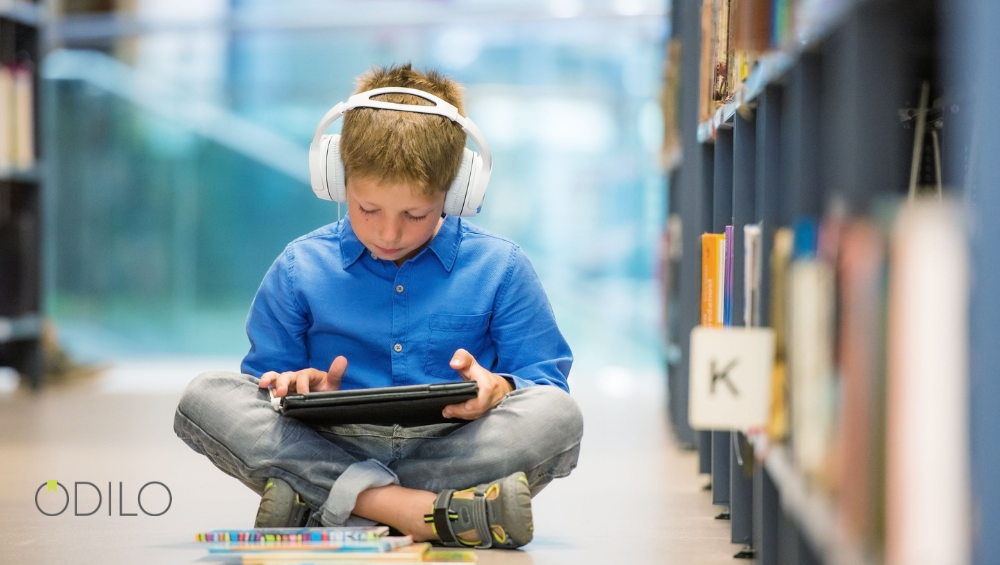Categories:
It is well known that reading is the key competency for all learning. According to PIRLS, for example, a house with 500 books gives children a 3-year school advance in their reading age.
It is not surprising then that there is a strong convergence from schools to amplifying their libraries to a digital experience. And with the power of an end to end digital experience that is well adapted to multiple pedagogical methods, teachers and parents can be empowered with more insights than ever about their students and reading activity can dramatically increase.
ODILO, for example, is seeing reading activity increase 3-5 times per reader.
Now that the value of having digital libraries is quite transparent, the key question to answer really is: how do we build our perfect digital library for schools? Here are 10 recommendations:
- Content must be instinctively appealing. For your digital library to be attractive for students, teachers, and parents, it must have content that is relevant and in demand by all key stakeholders. The content must be curriculum aligned, but also highly complementary to encourage more leisurely reading outside the classroom. Bestsellers are paramount to have. Multi-lingual titles are essential to help cultivate your students to become global citizens.
- Content recommendations must be personalized like Netflix. Everyone is different – different interests, and habits. At the very core of your digital library that needs to be machine and highly contextualized learning. The solution needs to understand each individual user well and make particular recommendations on the titles that best suit him or her. Only in this manner, will we be able to yield the most engagement and more addictive reading habits. Think Netflix, but for educational purposes.
- Content must be curated and skills aligned. We are very busy and most of us don’t know which titles serve the best of our needs. We need to know which titles are best aligned with specific personal and professional skill development goals, whether it is negotiations, sales or mastering maths. There needs to be both a mix of expert and data-driven title curation aligned with these skills to help us reduce our content discovery time and ensure we are being productive.
- Multi-format. For your school digital library to be even more striking, it should support many formats, such as books, videos, audiobooks, magazines, and courses. In this manner, content can serve the best reading preferences of everyone, such as preferred voiceovers or bite-sized video streaming.
- Content must be centralized. As teachers and instructors will have a lot of their own content that they want to use as part of their lesson plans, it’s important to be able to have single access of all content to get the best engagement. Intelligent digital school library providers like ODILO can provide this.
- Multi-device reading needs to be supported. As learning should take place anywhere and everywhere, the vessel to deliver the content should be fully accessible at all locations. It is crucial to have a wonderful mobile and tablet experience.
- Full accessibility is important. To address all learning impairments, a school digital library must be fully inclusive and work both online and offline. Accessible capabilities such as text-to-speech, dyslexic content font, multiple colors, and font sizes are absolutely necessary.
- Painless for teachers. When you launch a new digital library, like most ed-tech solutions for schools, it is key that the teachers all understand its full potential. Not only does the solution need to be super intuitive, but it also needs a dedicated support team to train teachers upon deployment and help promote it across all users. In this manner, the digital library is seen as solely an enabler to helping them achieve their academic mission and not as a deterrent which is more “work” and wasted time for them.
- Measure its impact. It is paramount to understand how the digital library is impacting your students. Real-time reading activity and reading comprehension data generated by Virtual Classrooms are important to help inform our literacy programs and enable teachers to intervene faster. This way your school can start having a holistic, data-driven approach to your literacy programs and can create your own KPIs such as the number of titles read per student or performance in reading assessments.
- Gamify the experience. Students need to have fun when they read. Tools can be built-in the reading experience to encourage them to read more, such as storytelling within groups or interactive chats within book-club styled Virtual classrooms. However, the school can institutionalize fun initiatives to help cultivate even better reading habits. Examples can be creating leaderboards across their students for reading the most titles, reading times, receiving the best scores in their reading comprehension and much more.
If we carry out all of these recommendations, our students will be better readers, with greater critical thinking skills and will be able to read anytime, anywhere, even on vacation.
Parents will be more involved in their children’s learning and will also have access to thousands of digital titles, thus reinforcing further reading activity at home.
Also, the teachers will have a library adapted to their teaching methods, with a more efficient evaluation and a real-time intervention and monitoring of their students.
Contact us to experience an intelligent digital library demo and learn how to create your own digital library for your school.
